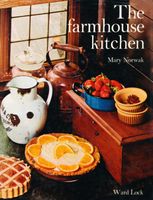Advertisement
Harvest Home
Appears in
By Mary Norwak
Published 1991

The harvest was always important in corn-growing Britain, and was widely celebrated by a ‘horkey’ or party; it is still commemorated by autumn thanksgiving services in churches throughout the land. Even the poorest labouring families would glean enough corn from the fields to supply their flour for the winter months.
Wheat, barley and oats were the three grains used for home baking. Wheat predominated in East Anglia, barley in the North, and oats in Scotland and Wales. Bread was made in most farm and cottage kitchens, and so were a wide variety of scones, pancakes or bannocks. All these plain baked goods were first made on a hot hearthstone since ovens were not built in most small homes until the nineteenth century. (Meat, cakes and pies were taken to the local baker’s oven.) From the eighteenth century on, however, most farmhouses of any size had a brick bread oven in which the bread was baked on the hot floor after raking out the hot ashes of a fire. Later still, the bread came to be baked in tins, to make the shapes of loaves we know now; but many traditional small baked goods are still griddle baked.

